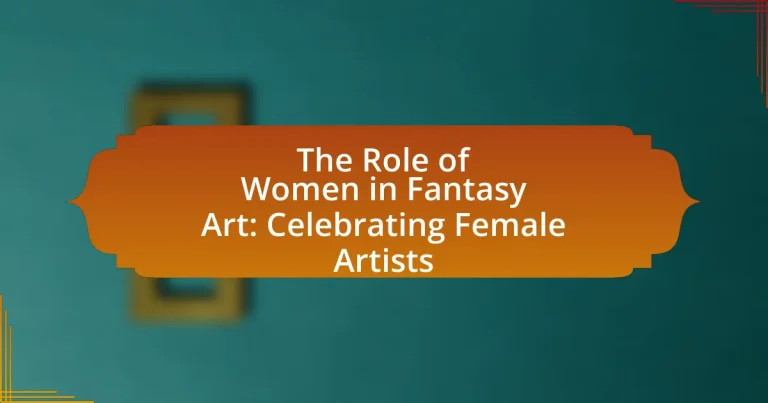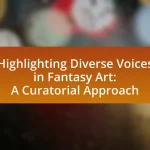The article examines the significant role of women in fantasy art, highlighting their contributions as both subjects and creators within the genre. It discusses how female artists, such as Julie Bell and Kinuko Y. Craft, have influenced the evolution of fantasy art by introducing diverse themes and challenging traditional gender representations. The article also explores historical contexts that have shaped women’s participation, societal perceptions affecting their roles, and the importance of celebrating female artists to promote inclusivity and representation. Additionally, it addresses the challenges women face in the industry, the impact of mentorship and exhibitions, and practical steps to support female artists in advancing their careers.
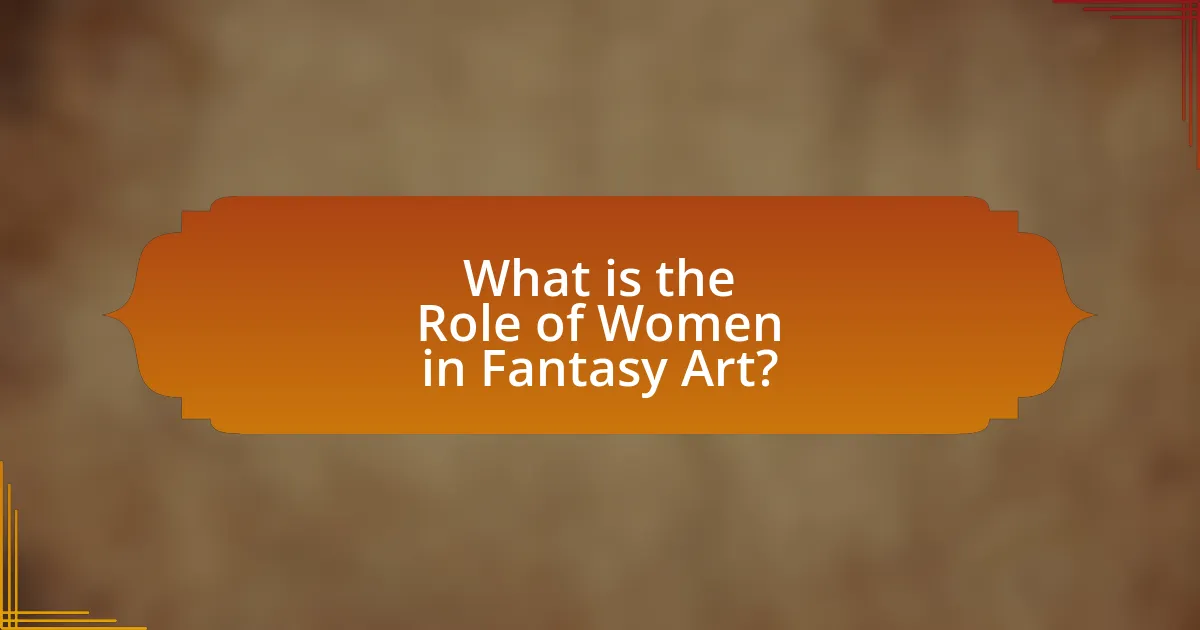
What is the Role of Women in Fantasy Art?
Women play a significant role in fantasy art by serving as both subjects and creators, influencing the genre’s themes and aesthetics. Female artists contribute unique perspectives that challenge traditional representations, often depicting strong, complex female characters and narratives that resonate with diverse audiences. For instance, artists like Julie Bell and Kinuko Y. Craft have gained recognition for their work that blends fantasy with elements of empowerment and individuality, showcasing women’s experiences and creativity in a predominantly male-dominated field. This shift not only enriches the visual landscape of fantasy art but also promotes greater inclusivity and representation within the genre.
How have women contributed to the evolution of fantasy art?
Women have significantly contributed to the evolution of fantasy art through their unique perspectives, innovative techniques, and influential works. Notable female artists such as Julie Bell and Kinuko Y. Craft have shaped the genre by introducing diverse themes and styles, often incorporating elements of mythology and personal experience. Their contributions have expanded the representation of female figures in fantasy, challenging traditional portrayals and inspiring future generations of artists. Additionally, women have played crucial roles in art movements and organizations that promote fantasy art, further solidifying their impact on the field.
What historical contexts influenced women’s participation in fantasy art?
Women’s participation in fantasy art has been influenced by several historical contexts, including the feminist movements of the 20th century, which advocated for gender equality and greater representation in the arts. The rise of the feminist art movement in the 1970s challenged traditional gender roles and encouraged women to explore and express their creativity in various artistic forms, including fantasy art. Additionally, the increasing visibility of women in the workforce and higher education during this period provided more opportunities for women to pursue careers in art. The emergence of science fiction and fantasy literature, particularly in the mid-20th century, also created a cultural space where female artists could contribute their unique perspectives, leading to a diversification of themes and styles in fantasy art. These historical contexts collectively fostered an environment that supported and celebrated women’s contributions to the genre.
How have societal perceptions of women shaped their roles in this genre?
Societal perceptions of women have significantly shaped their roles in fantasy art by often relegating them to stereotypical representations, which has influenced both the creation and reception of their work. Historically, women in fantasy art have been depicted primarily as muses or objects of beauty, reflecting broader societal views that prioritize male perspectives and narratives. For instance, the prevalence of the “damsel in distress” trope in fantasy art illustrates how women were often portrayed as passive figures needing rescue, reinforcing traditional gender roles. However, as societal perceptions have evolved, particularly with the feminist movements of the late 20th century, female artists have increasingly challenged these stereotypes, asserting their agency and creativity. This shift is evidenced by the rise of female-led fantasy art collectives and the growing visibility of women artists in exhibitions, which has allowed for more diverse and empowered representations of women in the genre.
Why is it important to celebrate female artists in fantasy art?
Celebrating female artists in fantasy art is important because it promotes diversity and representation within a genre that has historically marginalized women’s contributions. Female artists bring unique perspectives and narratives that enrich the fantasy genre, allowing for a broader range of stories and visual expressions. Research indicates that diverse representation in art leads to increased creativity and innovation, as seen in studies by the National Endowment for the Arts, which highlight the positive impact of varied voices in artistic fields. By recognizing and celebrating female artists, the fantasy art community not only acknowledges their contributions but also inspires future generations of women to engage in creative pursuits, fostering an inclusive environment that benefits the entire artistic landscape.
What impact do female artists have on the fantasy art community?
Female artists significantly enrich the fantasy art community by introducing diverse perspectives and innovative styles. Their contributions challenge traditional narratives and expand the representation of gender and identity within the genre. For instance, artists like Julie Bell and Kinuko Y. Craft have gained recognition for their unique interpretations of fantasy themes, which often incorporate elements of femininity and empowerment. This shift not only inspires a broader audience but also encourages emerging female artists to pursue their creative visions, thereby fostering a more inclusive and dynamic artistic environment.
How does recognition of female artists influence future generations?
Recognition of female artists significantly influences future generations by providing role models and validating the contributions of women in creative fields. When female artists are acknowledged, it encourages young girls to pursue their artistic ambitions, fostering a more inclusive environment in the arts. Studies show that visibility of successful female artists leads to increased participation of women in art-related disciplines; for instance, a report by the National Endowment for the Arts highlights that female representation in art exhibitions has a direct correlation with the number of women entering art schools. This recognition not only empowers future female artists but also challenges societal norms, promoting gender equality in the creative industry.
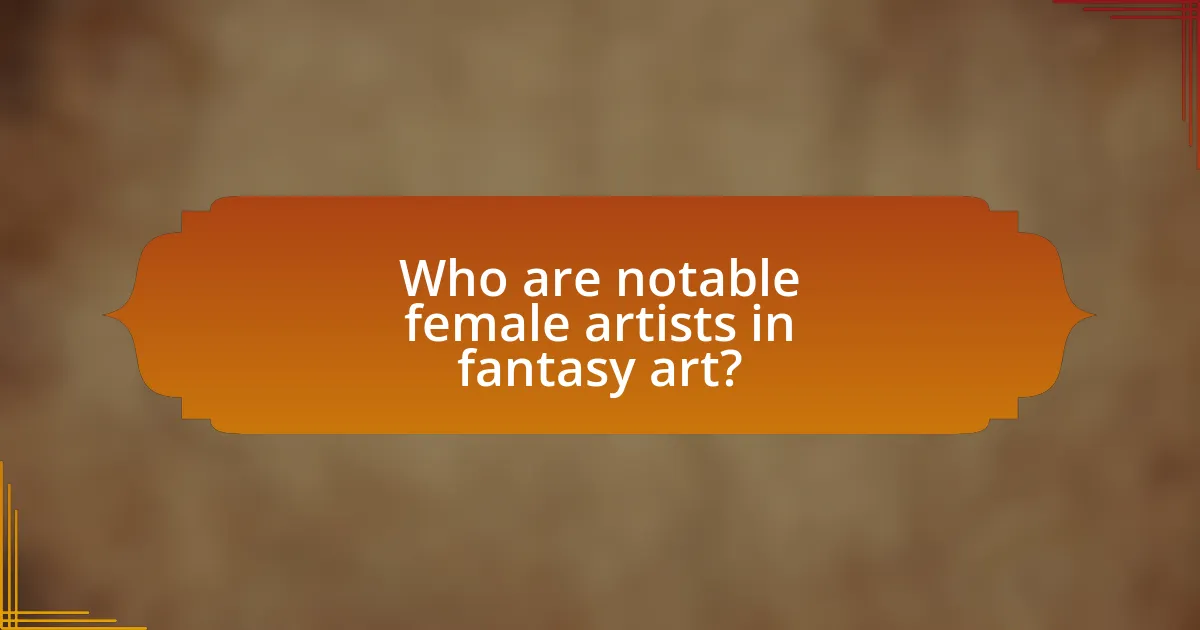
Who are notable female artists in fantasy art?
Notable female artists in fantasy art include Julie Bell, known for her dynamic illustrations and collaborations with Boris Vallejo; Rebecca Guay, recognized for her ethereal style and contributions to Magic: The Gathering; and Anne Stokes, famous for her gothic and fantasy-themed artwork. These artists have significantly influenced the genre, showcasing their unique visions and styles, which have garnered them a dedicated following and critical acclaim in the fantasy art community.
What are the key works of influential female fantasy artists?
Key works of influential female fantasy artists include “The Midsummer Night’s Dream” by Julie Bell, “The Faerie Queene” illustrations by Kinuko Y. Craft, and “The Dragon Prince” series by Rebecca Guay. Julie Bell’s work is recognized for its vibrant colors and dynamic compositions, often featuring strong female figures. Kinuko Y. Craft’s illustrations are celebrated for their intricate detail and ethereal quality, bringing classic literature to life. Rebecca Guay’s contributions to graphic novels and illustrations have garnered acclaim for their unique style and storytelling depth. These artists have significantly shaped the fantasy art genre, showcasing the diverse talents and perspectives of women in this field.
How do these works reflect the unique perspectives of female artists?
The works of female artists in fantasy art reflect unique perspectives through their exploration of themes such as identity, empowerment, and emotional depth. Female artists often challenge traditional gender roles and portray strong, complex female characters, which can be seen in the works of artists like Julie Bell and Kinuko Y. Craft, who emphasize female strength and individuality. Additionally, these artists frequently incorporate personal narratives and cultural experiences into their art, providing a distinct viewpoint that contrasts with the male-dominated narratives prevalent in the genre. This is evidenced by the increasing recognition of female artists in exhibitions and awards, highlighting their contributions to the evolution of fantasy art and the representation of women within it.
What themes are commonly explored by these artists in their work?
Female artists in fantasy art commonly explore themes of empowerment, identity, and the subversion of traditional gender roles. These themes reflect a desire to challenge societal norms and portray women as strong, multifaceted characters. For instance, many works depict female figures in positions of power or as heroic protagonists, which contrasts with historical representations of women in art. Additionally, artists often incorporate elements of mythology and fantasy to express personal narratives and cultural identities, further enriching the thematic landscape of their work.
How have female artists changed the landscape of fantasy art?
Female artists have significantly transformed the landscape of fantasy art by introducing diverse perspectives and themes that challenge traditional representations. Artists like Julie Bell and Kinuko Y. Craft have brought a unique blend of femininity and strength to their work, often depicting powerful female characters in fantastical settings. This shift has encouraged a broader acceptance of varied narratives and styles within the genre, moving away from male-dominated tropes. Furthermore, the rise of platforms such as social media has allowed female artists to gain visibility and build communities, leading to increased recognition and opportunities in the fantasy art field. This evolution reflects a growing appreciation for the contributions of women, ultimately enriching the fantasy art landscape with more inclusive and varied artistic expressions.
What innovative techniques have female artists introduced?
Female artists have introduced innovative techniques such as digital painting, mixed media, and collaborative art projects. Digital painting has revolutionized the fantasy art landscape, allowing artists like Julie Dillon to create intricate and vibrant works using software tools, which enhances creativity and efficiency. Mixed media techniques, employed by artists such as Yuko Shimizu, combine traditional and contemporary materials, resulting in unique textures and visual narratives. Collaborative art projects, exemplified by initiatives like the “Women of Illustration” collective, foster community and shared creativity, pushing the boundaries of individual artistic expression. These techniques not only showcase the versatility of female artists but also contribute significantly to the evolution of fantasy art.
How do female artists challenge traditional fantasy art norms?
Female artists challenge traditional fantasy art norms by introducing diverse perspectives and reimagining character archetypes. They often depict strong, complex female characters that defy the typical portrayal of women as passive or overly sexualized, thereby broadening the narrative scope within the genre. For instance, artists like Julie Bell and Kinuko Y. Craft have created works that emphasize empowerment and agency, showcasing women in roles that highlight their strength and intelligence rather than conforming to conventional tropes. This shift not only enriches the visual landscape of fantasy art but also encourages a more inclusive representation of gender, as evidenced by the increasing recognition of female artists in major exhibitions and awards, such as the Spectrum Fantastic Art Awards, which celebrate innovative contributions to the field.
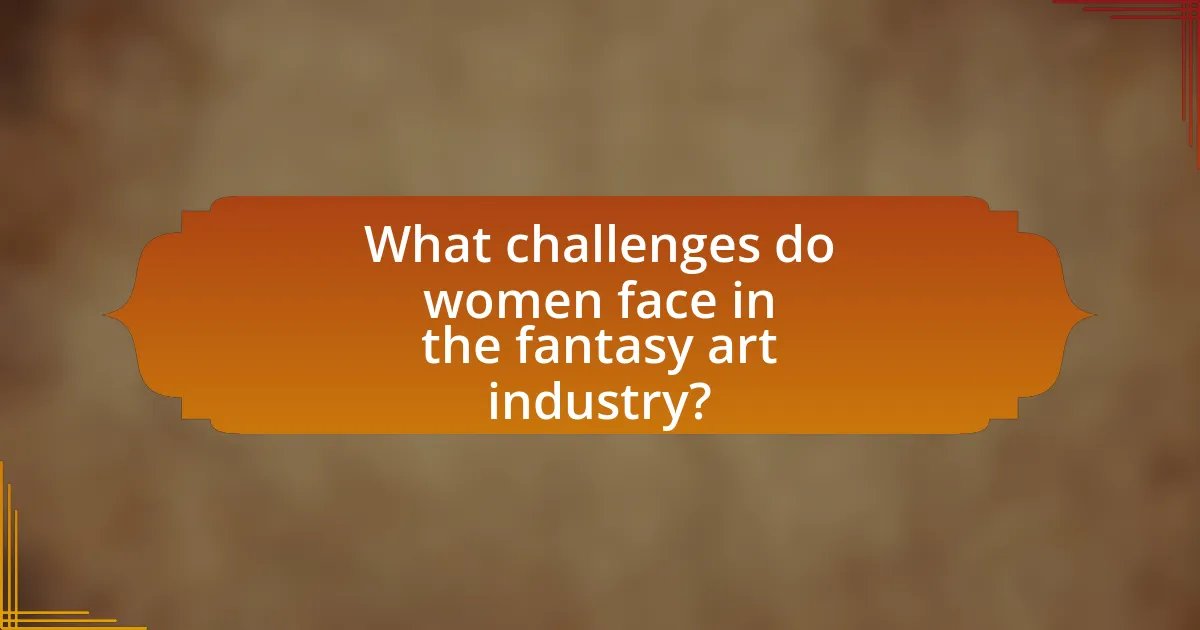
What challenges do women face in the fantasy art industry?
Women in the fantasy art industry face significant challenges, including gender bias, underrepresentation, and limited access to opportunities. Gender bias manifests in the form of stereotypes that question women’s technical skills and artistic credibility, often leading to their work being undervalued compared to male counterparts. Underrepresentation is evident, as studies show that women constitute only a small percentage of artists in major fantasy art exhibitions and publications, which limits visibility and recognition. Additionally, women often encounter barriers in networking and mentorship opportunities, which are crucial for career advancement in a predominantly male-dominated field. These challenges collectively hinder women’s ability to thrive and gain equal footing in the fantasy art industry.
How do gender biases affect female artists in fantasy art?
Gender biases significantly hinder female artists in fantasy art by limiting their visibility and opportunities within the industry. Female artists often face stereotypes that question their authority and expertise in a genre traditionally dominated by male creators, leading to underrepresentation in galleries, exhibitions, and publications. Research indicates that women comprise only about 30% of artists represented in major art institutions, which reflects a systemic bias that affects their career advancement and recognition. Furthermore, female artists frequently encounter challenges such as gendered criticism and a lack of mentorship, which can stifle their creative expression and professional growth.
What barriers do women encounter when gaining recognition?
Women encounter several barriers when gaining recognition in the field of fantasy art, including gender bias, lack of representation, and limited access to networks. Gender bias manifests in the undervaluation of women’s work compared to their male counterparts, often leading to fewer opportunities for exhibitions and commissions. Research indicates that women artists are frequently overlooked in major art events and galleries, with studies showing that only 30% of artists represented in galleries are women. Additionally, the lack of representation in the industry creates a cycle where aspiring female artists have fewer role models and mentors, further hindering their visibility. Limited access to professional networks restricts women’s ability to connect with influential figures in the art world, which is crucial for gaining recognition and advancing their careers.
How can these challenges be addressed within the art community?
To address challenges faced by women in the art community, initiatives must focus on increasing visibility and representation of female artists. Programs that promote female-led exhibitions and mentorship opportunities can help elevate their work and provide necessary support. Research indicates that women artists are often underrepresented in galleries, with only 30% of artists in major exhibitions being female, highlighting the need for targeted efforts to rectify this imbalance. Additionally, creating platforms for dialogue about gender equity in art can foster a more inclusive environment, encouraging collaboration and recognition of female contributions in fantasy art.
What initiatives support female artists in fantasy art?
Initiatives that support female artists in fantasy art include organizations like the Association of Women Artists, which promotes the work of female artists through exhibitions and networking opportunities. Additionally, platforms such as ArtStation and DeviantArt have specific features and contests aimed at highlighting female creators, fostering visibility and community engagement. Furthermore, grants and scholarships, such as those offered by the Elizabeth Greenshields Foundation, specifically encourage female artists in their artistic pursuits, providing financial support to develop their work. These initiatives collectively enhance the representation and recognition of women in the fantasy art genre.
How do mentorship programs benefit aspiring female artists?
Mentorship programs benefit aspiring female artists by providing guidance, support, and networking opportunities that enhance their artistic development and career prospects. These programs connect emerging artists with experienced mentors who can offer personalized advice, share industry insights, and help navigate challenges specific to women in the arts. Research indicates that mentorship can significantly increase the likelihood of career advancement; for instance, a study by the American Association of University Women found that women with mentors are more likely to pursue leadership roles and achieve higher levels of success in their fields.
What role do art exhibitions play in promoting female artists?
Art exhibitions play a crucial role in promoting female artists by providing them with visibility and recognition in a predominantly male-dominated art world. These exhibitions create platforms for female artists to showcase their work, connect with audiences, and engage with the art community. For instance, events like the “Women in Art” exhibition series have highlighted the contributions of female artists, leading to increased sales and opportunities for collaboration. Furthermore, statistics indicate that exhibitions featuring female artists can significantly boost their representation in galleries and museums, which historically have underrepresented women. This visibility not only elevates individual artists but also fosters a broader cultural appreciation for women’s contributions to the art world.
What practical steps can be taken to support female artists in fantasy art?
To support female artists in fantasy art, organizations and individuals can implement mentorship programs that connect emerging female artists with established professionals in the field. These programs can provide guidance, networking opportunities, and skill development, which are crucial for career advancement. Research indicates that mentorship significantly enhances career outcomes for women in creative industries, as highlighted in a study by the National Endowment for the Arts, which found that mentorship increases visibility and access to resources for female artists. Additionally, promoting female artists through exhibitions, social media campaigns, and funding opportunities can further elevate their work and ensure they receive recognition in a predominantly male-dominated genre.
How can art collectors and enthusiasts contribute to this cause?
Art collectors and enthusiasts can contribute to the cause of celebrating female artists in fantasy art by actively purchasing and promoting works created by women. This financial support directly impacts female artists’ visibility and sustainability in the art market. According to a report by the National Museum of Women in the Arts, artworks by women artists represent only 11% of the collections in major U.S. museums, highlighting the need for increased patronage. By prioritizing the acquisition of pieces from female artists, collectors can help shift this imbalance and encourage galleries and institutions to showcase more works by women. Additionally, enthusiasts can advocate for female artists through social media platforms, share their work, and participate in exhibitions that focus on women in art, further amplifying their presence in the industry.
What resources are available for female artists seeking to advance their careers?
Female artists seeking to advance their careers can access various resources, including grants, mentorship programs, and networking opportunities specifically designed for women in the arts. Organizations such as the National Museum of Women in the Arts provide funding and support for female artists, while platforms like ArtGirlRising offer mentorship and community connections. Additionally, initiatives like the Women’s Studio Workshop provide residencies and workshops aimed at empowering women artists. These resources are crucial for fostering professional growth and visibility in a historically male-dominated field.
